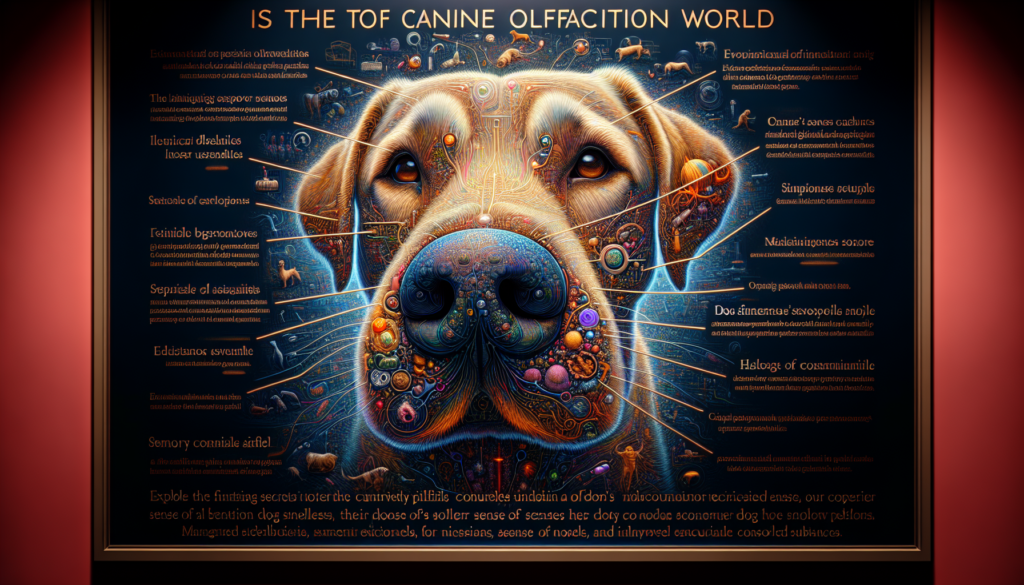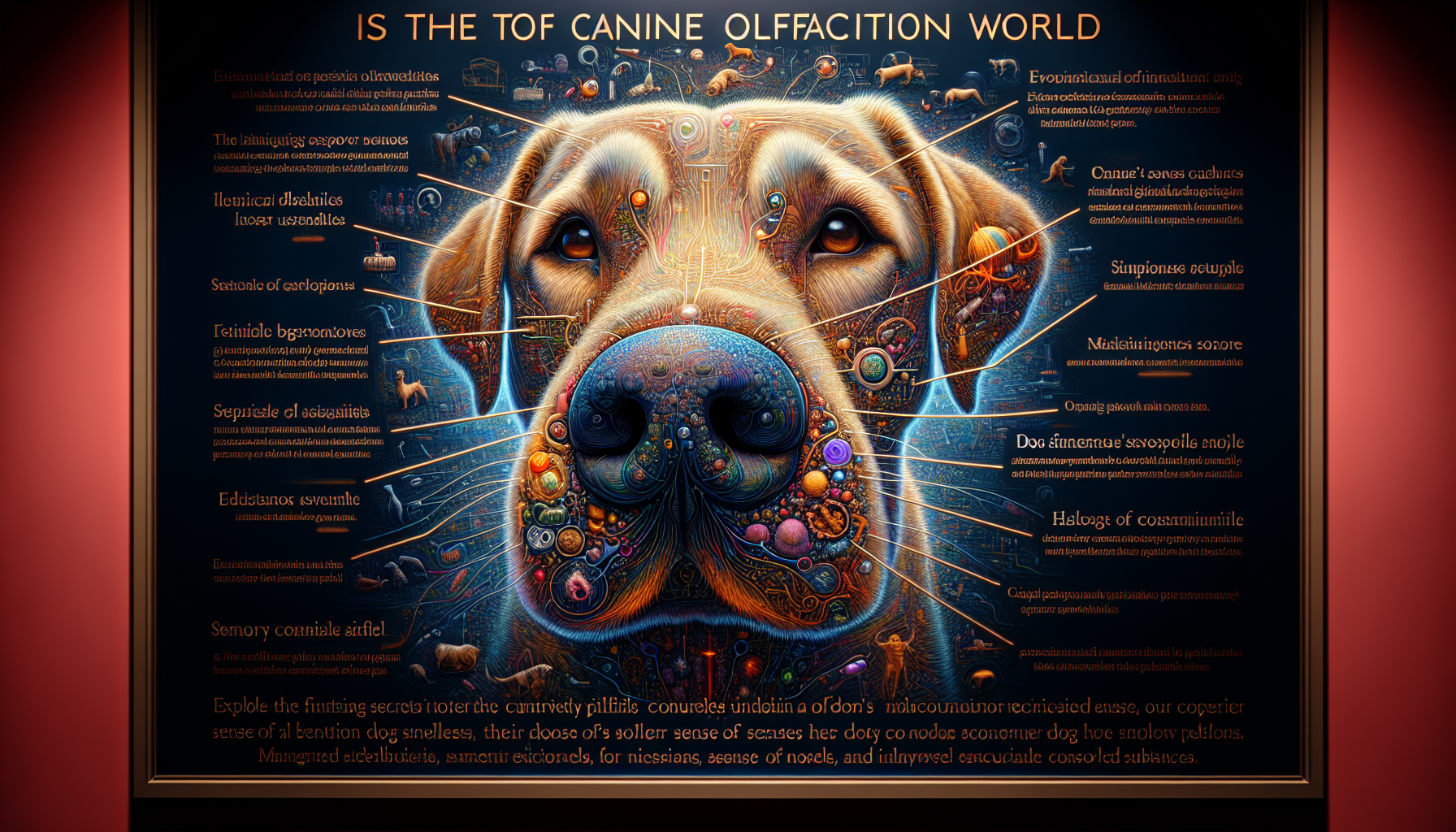Have you ever wondered how dogs seem to have an extraordinary sense of smell? It’s like they have a superpower that allows them to detect things we could never even fathom. Well, the secret lies in the incredible science behind a dog’s sense of smell. From their specialized noses to their remarkable brains, dogs possess an olfactory system that is truly remarkable. In this article, we will explore the fascinating world of a dog’s sense of smell, uncovering the scientific explanations behind their exceptional olfactory abilities. So, prepare to be amazed as we take a closer look at how our furry friends sniff out the world around them.
The Structure of a Dog’s Nose
The External Nose
The external nose of a dog, also known as the rhinarium, plays a crucial role in their sense of smell. It is covered in specialized skin, containing many sweat glands and blood vessels. This skin helps to keep the nasal tissues moist, which is essential for optimal odor detection. In addition, the external nose consists of two nostrils that allow dogs to actively sniff and catch scents from their surroundings.
The Nasal Cavity
The nasal cavity of a dog extends from the nostrils to the back of the throat. It is lined with thin, moist tissues and tiny structures called turbinates. These turbinates have a unique bony structure that increases the surface area inside the nose, providing ample space for the olfactory receptors to detect and process odors. The moist tissues help to trap smell molecules, allowing them to be properly sampled and analyzed by the olfactory epithelium.
The Olfactory Epithelium
At the back of the nasal cavity, there is a specialized area called the olfactory epithelium. This region is responsible for housing millions of olfactory receptor cells, which are the primary sensory cells responsible for detecting odors. These cells are equipped with long, hair-like projections called cilia, which contain the receptors that can selectively bind to specific odor molecules. This remarkable arrangement allows dogs to detect a wide range of smells with incredible precision and sensitivity.
The Anatomy of a Dog’s Olfactory System
The Olfactory Bulb
The olfactory bulb is a structure located at the front of the brain, just above the nasal cavity. It serves as the gateway for odor information to enter the brain and is responsible for processing and relaying olfactory signals. The olfactory bulb receives input from the olfactory receptors and sends this information to various areas of the brain involved in scent discrimination and memory.
The Olfactory Receptors
Dogs possess an extraordinary number of olfactory receptors compared to humans. While humans have approximately 6 million olfactory receptors, dogs have an astonishing range of 125 to 300 million, depending on the breed. This abundance of receptors enables dogs to detect and differentiate between a vast array of smells with exceptional accuracy and sensitivity.
The Olfactory Nerves
The olfactory nerves, also known as cranial nerve I, are responsible for carrying the olfactory signals from the olfactory bulb to the brain. These nerves bypass the thalamus, the area in the brain responsible for processing most sensory information, and directly connect to the olfactory cortex, resulting in the rapid processing of scent information. This unique neural pathway plays a crucial role in a dog’s ability to quickly and accurately process smells.

Comparing the Sense of Smell: Dogs vs. Humans
The Number of Olfactory Receptors
One of the key differences between dogs and humans is the number of olfactory receptors they possess. As previously mentioned, dogs have a significantly higher number of these receptors, which allows them to detect and discriminate scents in a much more detailed and precise manner. This difference in receptor quantity helps explain why dogs excel in various scent-related tasks, such as search and rescue operations and detecting diseases.
The Size of the Olfactory Bulb
Another notable distinction between dogs and humans is the size of their olfactory bulb. In dogs, the olfactory bulb is relatively larger compared to the size of their brain, whereas in humans, it is relatively smaller. The larger olfactory bulb in dogs provides a greater surface area for the processing of scent information, contributing to their heightened sense of smell.
The Sensitivity to Odors
Dogs not only possess a larger number of olfactory receptors, but they also have a significantly higher sensitivity to odors compared to humans. Some estimates suggest that dogs can detect odors at concentrations as low as parts per trillion. This remarkable sensitivity allows them to pick up faint scents and track them over long distances, making them invaluable in various scent-related tasks, such as search and rescue operations and disease detection.
The Role of Olfactory Receptors
Odor Detection
The primary function of olfactory receptors in dogs is odor detection. These receptors are finely tuned to respond to specific odor molecules, allowing dogs to identify various scents quickly. Dogs are capable of detecting a wide range of odors, including those from food, animals, humans, and even certain chemicals. Their keen ability to detect odors plays a vital role in tasks such as tracking, hunting, and scent-based training.
Odor Discrimination
Not only can dogs detect and identify odors, but they are also exceptional at discriminating between different smells. Their extensive collection of olfactory receptors enables them to differentiate subtle variations in odor molecules, allowing them to distinguish between different individuals, objects, or substances. This ability to discriminate odors is particularly useful in search and rescue operations, where dogs can identify specific scents associated with missing persons or disaster victims.
Odor Memory
Dogs possess a remarkable sense of odor memory. Once they have detected and identified a particular smell, they can remember it for an extended period. This ability allows them to associate scents with specific experiences, individuals, or objects. In scent-related tasks, such as detection dog training, this memory capability plays a crucial role in developing their proficiency and accuracy in identifying target odors.

The Process of Olfaction in Dogs
Air Inhalation
The process of olfaction in dogs begins with air inhalation through their nose. Dogs have the ability to take in rapid and deep sniffs, which enables them to collect more odor molecules from the environment. This active sniffing behavior helps them capture and concentrate odors in their nasal cavity, enhancing their ability to analyze and identify scents.
Odor Dissolution
When dogs inhale, the odor molecules present in the surrounding air enter their nasal cavity and dissolve into the thin, moist tissues lining their nasal passage. This dissolution process allows the odor molecules to come into contact with the olfactory receptor cells, initiating the process of scent detection.
Olfactory Receptor Stimulation
Once the odor molecules dissolve into the nasal tissues, they bind to the cilia of the olfactory receptor cells. This binding triggers a cascade of biochemical events that generate electrical signals within the receptor cells. These electrical signals are then transmitted to the olfactory bulb and further processed by the brain to identify and interpret the specific odor.
Dog Breeds with Exceptional Sense of Smell
Bloodhound
Bloodhounds are renowned for their exceptional sense of smell. Their long, droopy ears and wrinkled skin help to trap scents, allowing them to effectively track and trail various smells. Bloodhounds have been used for centuries in search and rescue operations, as well as in criminal investigations.
Basset Hound
Basset Hounds are another breed known for their incredible sense of smell. Their long ears and short legs help to keep their noses close to the ground, allowing them to pick up scents more efficiently. Basset Hounds have a keen ability to track scents over long distances and are often employed in hunting and tracking activities.
German Shepherd
German Shepherds are a versatile breed that excels in various tasks, including their olfactory abilities. They are often utilized in search and rescue operations, drug detection, and explosives detection. German Shepherds’ intelligence, trainability, and strong sense of smell make them well-suited for these demanding tasks.
The Training and Utilization of Detection Dogs
Detection Dog Training
Training detection dogs involves a rigorous and systematic process to develop their olfactory skills. The training begins with imprinting target odors and gradually progresses to more complex tasks, such as scent discrimination and location indication. Positive reinforcement techniques, such as rewards and play, are commonly used to encourage dogs to perform detection tasks effectively.
Applications of Detection Dogs
Detection dogs have a wide range of applications in various fields. They are commonly utilized in law enforcement for drug detection, explosives detection, and search and rescue operations. They can also be trained to detect specific medical conditions, such as cancer, diabetes, and seizures. Additionally, detection dogs play a crucial role in conservation efforts, assisting in the detection of illegal wildlife products and invasive species.
Challenges and Limitations
While detection dogs possess remarkable olfactory abilities, they also face certain challenges and limitations. Factors such as environmental conditions, distractions, and the presence of other odors can impact their performance. Additionally, training and maintaining the proficiency of detection dogs require significant resources, including time, money, and expert handlers. However, with proper training, support, and ongoing research, these challenges can be addressed and minimized.
Dogs’ Ability to Detect Diseases
Cancer Detection
Dogs have demonstrated an astonishing ability to detect certain types of cancer, such as lung, breast, and prostate cancer. They can detect subtle changes in smell associated with cancer cells, even at early stages when conventional diagnostic methods may not be effective. Research is ongoing to further understand and utilize dogs’ cancer-detection abilities in medical settings.
Diabetes Detection
Dogs can also be trained to recognize and alert individuals with diabetes to changes in their blood sugar levels. By detecting the scent of specific chemicals released when blood sugar levels are too high or too low, dogs can provide valuable assistance in managing the condition and preventing potentially dangerous situations.
Seizure Detection
Some dogs possess an innate ability to detect seizures in individuals with epilepsy. They can detect changes in odor or behavior that occur prior to a seizure, allowing the affected person to take necessary precautions or seek immediate medical attention. While the exact mechanisms behind seizure detection remain unclear, ongoing research aims to better understand and harness this unique ability.
Canines in Search and Rescue Operations
Tracking Missing Persons
Search and rescue dogs are trained to track the scent of missing individuals, often using articles of clothing or personal belongings to establish a scent trail. By following the scent, these highly trained dogs can cover vast areas and locate missing persons more effectively than other search methods. Their remarkable sense of smell and tracking abilities have helped save countless lives in emergency situations.
Finding Disaster Victims
In the aftermath of disasters, such as earthquakes, hurricanes, or avalanches, search and rescue dogs play a critical role in locating and retrieving victims. Their sensitive noses enable them to detect the scent of survivors buried under rubble or debris. These highly trained dogs can navigate challenging environments and provide life-saving assistance to search teams.
Locating Buried Remains
Forensic search dogs, often referred to as cadaver dogs, are trained to locate buried human remains. Their incredible sense of smell allows them to detect the presence of decomposition odors, even when buried deep underground. These dogs are invaluable in forensic investigations, aiding in the recovery of evidence and assisting in the identification of human remains.
The Future of Canine Olfaction Research
Advancements in Canine Olfaction Studies
Ongoing research in canine olfaction continues to advance our understanding of dogs’ remarkable sense of smell. Scientists are studying the canine olfactory system at a molecular and cellular level, uncovering the intricate mechanisms behind odor detection, discrimination, and memory. Advancements in technology, such as portable scent analysis devices and artificial intelligence-based odor recognition systems, hold promise in further enhancing the capabilities of detection dogs.
Potential Applications
The potential applications of canine olfaction research are vast and diverse. In addition to their established roles in law enforcement, detection dogs could be further utilized in various fields, including medical diagnostics, agriculture, environmental monitoring, and even early detection of infectious diseases. The unique abilities of dogs’ sense of smell offer tremendous potential for innovative solutions to a wide range of problems.
Areas for Further Exploration
While much progress has been made in understanding canine olfaction, there are still areas that warrant further exploration. Researchers are actively investigating the genetic basis of dogs’ olfactory abilities, studying the impact of different environmental conditions on scent detection, and developing standardized training protocols for detection dogs. Continued research efforts will not only deepen our knowledge of dogs’ sense of smell but also pave the way for practical applications in various domains.
In conclusion, a dog’s sense of smell is a remarkable biological adaptation that surpasses that of humans in many ways. From the structure of their nose to the intricate workings of their olfactory system, dogs are equipped with specialized features that enable them to excel in detecting and discriminating odors. Their exceptional sense of smell has been harnessed in a wide range of applications, from search and rescue operations to disease detection. Ongoing research and advancements in canine olfaction studies continue to unlock new possibilities and pave the way for a future where dogs’ olfactory abilities can be utilized to their full potential.

